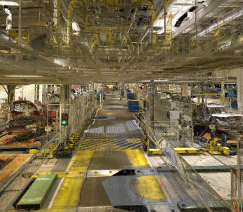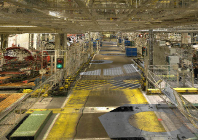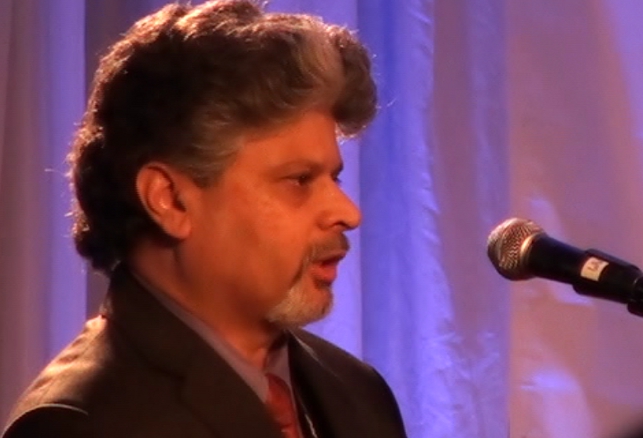Every year in a leafy suburb of Houston, the only dedicated scanning event brings together people from across the industry to catch up on the state of the art and meet important customers. Called SPAR, it is organised and run by SPAR Point Research, a company that primarily covers and consults on 3D scanning, imaging and position capture technologies. The company is headed up by Tom Greaves, who formerly worked for Daratech, a consulting group that focussed on CAD and Process Plant.

Rajeev Kalandani, virtual manufacturing supervisor, Ford Motor Company
In the past, the three-day symposium has reflected the industry’s niche focuses but with the expanded use of laser scanning and increased need to capture the real-world the show has been growing. This year’s event attracted 750 attendees, up over 23% on the year before. The topics covered ranged from Reverse Engineering and Avatar to Quality Control and detecting snowfall on Mars. The breadth of application for this technology is clearly mushrooming.
Avatar
The first keynote came from Paul Debevec associate director, graphics research, University of Southern California Institute for Creative Technologies (ICT). In a fascinating talk, we saw how laser and optical systems were capturing the real-world and being used to rebuild the Parthenon (complete with Elgin marbles) in a virtual Athens as well as providing life-like facial renderings in films like the Matrix and Avatar. Shortly after this talk, Debevec won an Oscar for his work on Avatar.
Digital Factories at Ford
Avatar technology keynotes are always a tough act to follow and many on the conference circuit have come up against someone who did a bit of work on the film. Rajeev Kalandani, Virtual Manufacturing Supervisor from Ford Motor Company was up next and he apologised for having to talk about digital factories for Powertrain assembly instead of aliens.
Kalandani’s talk was entitled, ‘Visualising the Elephant…in 3D – The changing paradigms in Powertrain Manufacturing at Ford’. The automotive world is in a transition from 2D to 3D. While the automotive design has been done in 3D for a considerable period of time, the manufacturing design is still in the process of moving to create virtual manufacturing environment. To design the manufacturing system for a Powertain design Ford allows 48 months lead-time before the first one rolls off the factory line.
With the traditional process, the manufacturing division could really only get seriously going when the product was fully designed, back loading the design of the manufacturing plant. By adopting an upfront virtual manufacturing approach, the assembly lines can be designed simultaneously with the product design, offering obvious benefits.
Also, as the products are designed in 3D, the manufacturing teams can now run casting and solidification analysis, Finite Element Analysis (FEA), CNC machining and virtual assembly line simulation. Everything can be tested virtually in the computer before the design is finished, improving quality and removing unwelcome surprises on fabrication.

A point cloud interior of a Volvo assembly plant comprising two billion points in total. Images courtesy of Volvo Car Corporation and PoinTools
Ford has a number of uses for scanners. Kalandani explained that as each component moves around the factory it sits in a bespoke pallet and these pallets are not cheap. Using scanning technology they can take a pallet, compare with new components, check for interference, redesign the cradle and issue a detailed rework order, saving time and a fortune in the process.
Another use of laser scanners is to capture each of its manufacturing plants (factories) in great detail, so they can run manufacturing simulation in the actual plant. Having decided to start with one plant,
Kalandani describes the fly through of the first colour cloud model of its Cleveland line as a watershed moment for senior management. The company can combine CAD as it moves through the assembly line with the point-cloud of the factory giving an amazing virtual experience. The result was more money to buy laser scanners and the directive to scan all 30 facilities worldwide.
The application of scanned data has been extended with the use of Autodesk’s Navisworks, which can mix both CAD geometry and point-cloud and provide clash detection, prior to any installation work.
Kalandani explained that while CAD models are precise in nature, they may not be accurate representations of ‘as built’. This is another major advantage of laser scanning. While Ford has many 2D drawings of its factories, the laser scans give rapid access to the as-built nature of the factory content. This can then be used to make design changes more accurately but it requires multiple applications to make any real use of the point-cloud; FSP Viewer, PoinTools View Pro, PoinTools Model, Navisworks and Geomagic Fashion are all used in conjunction with the FARO scanning equipment and software.
With all this processing, Kalandani stated that there was an increasing cost to working on turning point-cloud data to full parametric solid models.
Depending on what the data is used for, it’s not always necessary to spend time creating geometry from points. The lowest cost data is dumb points, then meshed surfaces, tessellated surfaces and finally CAD (solid models). Ford only solid models objects that are going to be physically manufactured, tessellation is used for visualisation, analysis and virtual assembly and mesh is for analysis and rapid prototyping. Coloured Pointclouds are great for quick visulaisation and can be used for clash detection.
The technology does not come without its issues. Aligning and segmenting data from large areas, in excess of 250,000 sq/ft means manipulating multi-GB files and there is never enough compute power. Alignment is an issue with 2D AutoCAD data and maintaining all this data is a headache! The interoperability, or lack of it is an area Kalandani would like to see improved, with a reduction in the number
of applications required.
Summing up Kalandani said ‘field checks’ were the killer application for laser scanning in Ford, saving money when integrating utilities and structural elements into existing facilities. Ford’s vision is to fabricate off-site and have plug and play installations.
Secret Service
With so many interesting tracks of talks given in parallel it was hard to see every presentation. Until the end of the event I had totally neglected to go the security sessions but a talk on how the army was
using laser scanning to find Improvised Explosive Devices (IEDs) in Iraq and Afghanistan seemed too interesting to miss. Unfortunately I missed it! The timetable had been switched as the heavy snow had played havoc with the arrival time of the presenters.
The potential savings of limiting errors and speeding new product manufacturing when multiplied throughout Ford’s global plants are huge
Instead I attended a fascinating presentation from the FBI on how it had scanned, modelled and rapid prototyped a semi-submerged drugs boat that had been caught, which had originated in Columbia.
There were strictly no cameras or audio allowed, so to see an image, Google search for ‘semi submersible cocaine Columbia’.
It appears that the drug barons are getting into manufacturing big time and have multiple jungle-based workshops where they assemble hundreds of these rather odd looking craft. They cost about $1 million each to manufacture and they launch them in flotillas of ten to fifteen in one go, each one is unique and not built to a plan. Sitting so low in the water they are very hard to detect and, if found, the operators frequently scuttle the boats. In fact once their payload is delivered the boats are scuttled anyway. Delivering $10 million of cocaine, at the cost of $1 million.
The FBI managed to catch one intact and a team was sent into laser scan the internal and exterior of the boat – not an easy task give the cramped access. From the point cloud data a detailed model was created in McNeel & Associates’ Rhino. The model allows agents to familiarise themselves with the craft and for analysis to be performed on the shape.
Travelling at slow speeds and leaving little wake these semi-subs are proving hard to track down. The American Coastguard is looking to try and identify the sound signatures of the engines so they can be picked up on its underwater listening equipment! However, more worryingly, the Columbian authorities have found a partially complete proper submarine in the jungle that was being constructed with Russian and American experts. It was scheduled to make regular drug deliveries to places as far away as Italy.
Conclusion
Traditionally, the use of laser scanning and probes in manufacturing has mainly been in reverse engineering and the inspection of parts. However, companies like Ford are starting to use the technology on many other aspects of their business, namely facilities and factory layout.
By combining dumb and intelligent data, Ford makes the most out of its investment, modelling in detail only essential assemblies. The end result is a virtually engineered vehicle and a virtually captured, designed and tested manufacturing facility. The potential savings of limiting errors and speeding new product manufacturing when multiplied throughout its global plants are huge.
SPAR Research – www.sparllc.com
PoinTools – www.pointools.com
Geomagic – www.geomagic.com
McNeel / Rhino – www.mcneel.com
Martyn Day visits SPAR to find the future of scanning technology






